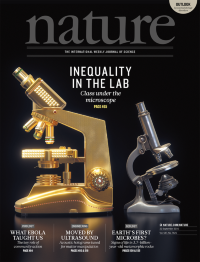Volume 537
-
No. 7622 29 September 2016
In October the United Nations will launch its New Urban Agenda at the Habitat III conference in Quito, Ecuador. In a Comment special in this issue, we air some of the topics that will come up in Quito. Joern Birkmann et al. explain that mid-sized cities are growing faster than mega cities, and need more protection from extreme events. In 15 years� time there will be a billion more people living on Earth than there are currently. Richard Forman and Jianguo Wu call for global and regional approaches to urban planning to cope with these numbers, focusing on the already-crowded Asian and African cities that will take much of the strain. Michele Acuto argues that the major cities need to be an integral part of global governance networks if they are to cope with their inevitable expansion. And Austin Williams reviews two new books that probe the dynamic relationship between people and the cities they inhabit.
-
No. 7621 22 September 2016
In this Nature Science and inequality� special issue we look at what science can say about inequality as a phenomenon, and the way inequality plays out within the science workforce. Economist Branko Milanovic uses historical data to follow the ebb and flow of inequality on a timescale of centuries. Mike Savage tackles the question of what class� actually means. And in two News Features we look in detail at what inequality means within science itself. Cover art: Peter Crowther
-
No. 7620 15 September 2016
A Hawaiian crow using a stick tool to extract food from a wooden log. Birds in the crow family are renowned for their cognitive abilities. The New Caledonian crow Corvus moneduloides is well known for its ability to make and use foraging tools. Christian Rutz et al. show that it is not some lone outlier � it is now joined by another species from the Pacific, the Hawaiian crow Corvus hawaiiensis, better known by its indigenous Hawaiian name Alalā. These birds naturally develop tool-using skills when young, and proficient tool use is a species-wide capacity. The authors can say this with confidence as the Alalā is extinct in the wild, and they were able to test 104 of the 109 surviving members of the species at the time, all in captivity. The research suggests that the technological skills of tropical crows might be fostered by rather unusual ecological circumstances found on remote islands, such as reduced competition for embedded prey and low predation risk. The discovery of a second tool-using crow species opens up exciting opportunities for comparative studies on animal tool use. Cover photo: Ken Bohn/San Diego Zoo Global
-
No. 7619 8 September 2016
This issue of Nature celebrates the science fiction genre. We have an extended version of our regular science fiction feature, Futures (page xxx). H. G. Wells is primarily known today, 150 years since his birth, as a writer of science fiction novels that still have a place in modern consciousness � including The Time Machine, The War of the Worlds, The Invisible Man and The First Men in the Moon. Simon James takes a look at Wellss science fiction and the rest of his vast output on education, history and politics, as well as fifty � we think� contributions to Nature (page xxx). Star Trek has been boldly going for 50 years, duly noted by Sidney Perkowitz, who reports on the impacts of the franchise on science, technology and society (page xxx).
-
No. 7618 1 September 2016
Amyloid plaque reduction with aducanumab, seen in example amyloid PET images at baseline and week 54. Aducanumab is a recombinant human monoclonal antibody that selectively targets the amyloid- (A) peptide aggregates thought to play a part in the neurodegenerative process in Alzheimers disease. Several Alzheimers disease drugs have faltered during development in recent years, so there is intense interest in any new results. A new study reports interim results from a clinical trial of monthly infusions of aducanumab in subjects with prodromal or mild Alzheimers disease. Treatment with aducanumab reduced brain A plaques, an action accompanied by a dose-dependent slowing of clinical decline. The trial data support further development of aducanumab as an A-removing therapy.





